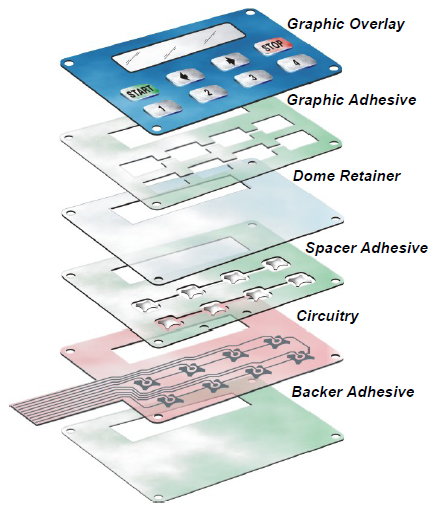The services offered by a professional membrane switch manufacturer go beyond standard production.
The services offered by a professional membrane switch manufacturer go beyond standard production.
Blog Article
Everything About Membrane Layer Switch: Understanding Its Layout and Capability
When you think of the control user interfaces in modern tools, membrane layer switches frequently come to mind. These components are extra than simply buttons; they blend design and performance perfectly. Understanding exactly how they function and what makes them reliable can change your perspective on day-to-day electronics. There are subtleties to their design and efficiency that you could not be mindful of. Allow's discover what collections membrane layer changes in addition to other control systems.
What Are Membrane Buttons?

Membrane switches can likewise be personalized concerning shape, size, and graphics, allowing producers to create one-of-a-kind interfaces tailored to specific products. On the whole, membrane layer buttons play a substantial duty in boosting individual experience across a broad range of applications.
Exactly How Membrane Switches Over Job
When you push a trick on a membrane layer switch, it triggers a simple yet effective system. membrane switch manufacturer. The leading layer, commonly made of adaptable material, presses down onto a conductive layer underneath it.
You'll see that the responsive responses varies based upon the switch design, using either a soft click or an extra noticable response. As soon as you release the trick, the membrane layer returns to its original setting, resuming the circuit and quiting the signal. This procedure happens practically immediately, making sure a receptive user experience.
Membrane layer buttons are preferred because of their longevity and resistance to dirt and moisture, making them excellent for different applications, from household devices to medical gadgets. Recognizing this procedure helps you value their prevalent usage.
Trick Elements of Membrane Switches
Understanding the essential parts of membrane switches is essential for realizing their capability and layout. At the core, you'll discover the graphic overlay, which supplies the visual interface for customers. Under that, there's a spacer layer that divides the circuit layers, making certain that they don't make call till pushed. The circuit layer is where the magic happens; it consists of conductive traces that finish the circuit when you push the button. One more vital component is the sticky backing, permitting the switch to follow surface areas firmly. Lastly, the safety layer shields versus ecological variables and use, prolonging the switch's lifespan. Each component plays a considerable duty in ensuring reputable efficiency and customer communication. By comprehending these components, you'll get understanding right into exactly how membrane switches run and their importance in various applications.
Products Used in Membrane Layer Change Layout
The efficiency and sturdiness of membrane changes heavily rely on the products used in their design. You commonly come across polyester and polycarbonate as main substratums because of their excellent strength and flexibility. These materials stand up to scratches and chemicals, making them excellent for demanding environments.
The conductive layers commonly use silver or carbon, selected for their integrity and conductivity. membrane switch manufacturer. Silver gives premium efficiency, while carbon is a cost-efficient choice. For the overlay, you could consider a matte or glossy surface, depending on your visual needs and user experience
Make particular to choose adhesives that withstand environmental variables like temperature level and moisture. Picking the ideal products will certainly guarantee your membrane layer switch stands the test of time.
Design Factors To Consider for Membrane Switches
While developing membrane layer switches, it's essential to take right into account different factors that influence their performance and individual experience. Begin by concentrating on the design and button dimension; make particular they're intuitive and very easy to navigate.
Verify your style fits ecological variables, like wetness or temperature level variations, which might influence performance. By very carefully thinking about these components, you'll create a membrane layer switch that boosts functionality and complete satisfaction.
Applications of Membrane Switches
Membrane switches are versatile components discovered in numerous applications, from industrial equipment to customer electronics. You'll see their impact in makers that need resilient interfaces and in devices that gain from streamlined designs. Understanding these applications helps you value the performance and functionality of membrane layer switches in daily innovation.
Industrial Devices Usage
When you're looking to boost the performance of industrial devices, membrane buttons provide a trustworthy service that integrates durability with easy to use style. These buttons are excellent for harsh atmospheres, supplying resistance to dirt, dampness, and chemicals. Welcome membrane layer buttons to streamline your operations and improve overall performance.
Consumer Electronics Integration
In the domain of consumer electronic devices, membrane layer buttons play a crucial role in enhancing user interaction and device functionality. You'll find them in devices like microwaves, remote controls, and video gaming consoles, providing a seamless way to communicate with innovation. Their smooth style permits simple combination into different products, making controls user-friendly and straightforward. With their capacity to incorporate graphics and backlighting, you can take pleasure in a modern-day aesthetic that matches the gadget's general appearance. Membrane layer switches likewise assure toughness and resistance to dust and moisture, extending the life expectancy Continued of your electronics. By picking membrane switches, you improve not simply the performance but likewise the style of your gadgets, making day-to-day communications smooth and pleasurable.
Advantages and Downsides of Membrane Switches
While membrane buttons offer a series of advantages, they likewise come with some downsides that you should consider. One significant advantage is their small design, making them suitable for space-constrained applications. They're also economical, providing a resilient remedy with a low manufacturing expense. Additionally, their seamless surface area is easy to clean, improving health in environments like hospitals.

Membrane layer buttons can have a shorter lifespan contrasted to mechanical buttons, especially under hefty usage. They can additionally be much less responsive, which might affect user responses throughout operation. Stabilizing these pros and disadvantages will aid you figure out if membrane layer buttons are the appropriate fit for read this article your task.
Regularly Asked Concerns
How Much Time Do Membrane Changes Normally Last?
Membrane layer switches over normally last between 5 to one decade, depending on usage and ecological conditions. You'll intend to examine factors like wear, exposure to dampness, and temperature level changes to evaluate their durability successfully.
Can Membrane Layer Changes Be Customized for Details Layouts?
Yes, you can personalize membrane buttons to fit specific styles (membrane switch manufacturer). You'll have the liberty to pick shades, shapes, and designs that match your project's demands, guaranteeing they blend flawlessly with your overall aesthetic
What Is the Expense Range for Membrane Switch Over Production?
The expense array for membrane layer switch manufacturing usually falls in between $1 and $10 per device, depending on aspects like layout intricacy, amount, and products. You can obtain quotes from producers to discover the ideal choice.

Are Membrane Switches Water Resistant or Immune?
Membrane switches can be created to be waterproof or resistant, depending upon products made use of and construction approaches. If you need them for damp settings, assure you define those requirements during the layout process.
How Do Membrane Switches Compare to Conventional Switches?
Membrane switches are generally thinner and more versatile than traditional buttons, offering a sleek design. They're typically less complicated to cleanse and integrate, however could not supply the responsive feedback you're utilized to with mechanical alternatives.
Verdict

Report this page